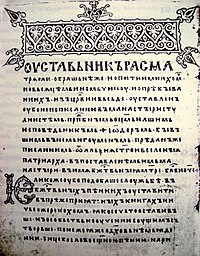 Global Information
Global InformationOld Church Slavonic information
| Old Church Slavonic | |
|---|---|
| Old Church Slavic | |
| Ⱌⱃⱐⰽⱏⰲⱐⱀⱁⱄⰾⱁⰲⱑⱀⱐⱄⰽⱏ ⱗⰸⱏⰺⰽⱏ Црькъвьнословѣ́ньскъ ѩꙁꙑ́къ | |
 | |
| Native to | Formerly in Slavic areas under the influence of Byzantium (both Catholic and Orthodox) |
| Region |
|
| Era | 9th–11th centuries; then evolved into several variants of Church Slavonic including Middle Bulgarian |
Language family | Indo-European
|
Writing system | Glagolitic, Cyrillic |
| Language codes | |
| ISO 639-1 | cu |
| ISO 639-2 | chu |
| ISO 639-3 | chu (includes Church Slavonic) |
| Glottolog | chur1257 Church Slavic |
| Linguasphere | 53-AAA-a |
Old Church Slavonic[1] or Old Slavonic (/sləˈvɒnɪk, slæˈvɒn-/ slə-VON-ik, slav-ON-)[a] is the first Slavic literary language.
Historians credit the 9th-century Byzantine missionaries Saints Cyril and Methodius with standardizing the language and undertaking the task of translating the Gospels and necessary liturgical books into it[9] as part of the Christianization of the Slavs.[10][11] It is thought to have been based primarily on the dialect of the 9th-century Byzantine Slavs living in the Province of Thessalonica (in present-day Greece).
Old Church Slavonic played an important role in the history of the Slavic languages and served as a basis and model for later Church Slavonic traditions, and some Eastern Orthodox and Eastern Catholic churches use this later Church Slavonic as a liturgical language to this day.
As the oldest attested Slavic language, OCS provides important evidence for the features of Proto-Slavic, the reconstructed common ancestor of all Slavic languages.
- ^ a b Wells, John C. (2008), Longman Pronunciation Dictionary (3rd ed.), Longman, ISBN 978-1-40588118-0
- ^ Jones, Daniel (2003) [1917], Roach, Peter; Hartmann, James; Setter, Jane (eds.), English Pronouncing Dictionary, Cambridge: Cambridge University Press, ISBN 978-3-12-539683-8
- ^ Malkiel 1993, p. 10.
- ^ Lunt, Horace G. (1974). Old Church Slavonic grammar – With an epilogue: Toward a generative phonology of Old Church Slavonic. Berlin: De Gruyter Mouton. pp. 3, 4. ISBN 978-3-11-119191-1.
Since the majority of the early manuscripts which have survived were copied in the Bulgaro-Macedonian area and since there are certain specifically Eastern Balkan Slavic features, many scholars have preferred to call the language Old Bulgarian, although Old Macedonian could also be justified. In the nineteenth century there was a theory that this language was based on the dialect of Pannonia, and accordingly the term Old Slovenian was adopted for a time. … The older term "Middle Bulgarian", invented to distinguish younger texts from "Old Bulgarian" (=OCS), covers both the fairly numerous mss from Macedonia and the few from Bulgaria proper. There are some texts which are hard to classify because they show mixed traits: Macedonian, Bulgarian and Serbian.
- ^ Gamanovich, Alypy (2001). Grammar of the Church Slavonic Language. Printshop of St Job of Pochaev: Holy Trinity Monastery. p. 9. ISBN 0-88465064-2.
The Old Church Slavonic language is based on Old Bulgarian, as spoken by the Slavs of the Macedonian district. In those days the linguistic differences between the various Slavic peoples were far less than they are today…
- ^ Flier, Michael S (1974). Aspects of Nominal Determination in Old Church Slavic. De Gruyter Mouton. p. 31. ISBN 978-90-279-3242-6.
'Old Church Slavic' is only one of many terms referring alternately to the language of a number of translations made by Cyril and Methodius in the middle of the ninth century to be used for liturgical purposes in the Great Moravian State,… (For example, Old Church Slavonic, Old Bulgarian, Old Slovenian.)
- ^ Adams, Charles Kendall (1876). Universal Cyclopædia and Atlas. Vol. 10. D. Appleton. pp. 561–2. ISBN 978-1-23010206-1.
Constantine (later called Monk Cyril) founded a literary language for all the Slavs – the so-called Church Slavonic or Old Bulgarian (or Old Slovenian), which served for many centuries as the organ of the Church and of Christian civilization for more than half of the Slavic race. … At the outset Dobrowsky recognized in it a southern dialect, which he called at first Old Servian, later Bulgaro-Servian or Macedonian. Kopitar advanced the hypothesis of a Pannonian-Carantanian origin, which Miklosich followed with slight modifications. From these two scholars comes the name Old Slovenian. Safarik defended the Old Bulgarian hypothesis, more on historical than on linguistic grounds. The name Old Slovenian is still used because in native sources the language was so-called, slovenisku (slovenica lingua), but it is now known to have been a South Slavic dialect spoken somewhere in Macedonia in the ninth century, having the most points of contact not with modern Slovenian, but with Bulgarian.
- ^ Arthur De Bray, Reginald George (1969). Guide to the Slavonic Languages. J. M. Dent & Sons. p. 16. ISBN 978-0-46003913-0.
This book starts with a brief summary of the phonetics and grammar of Old Slavonic (also called Old Bulgarian).
- ^ Abraham, Ladislas (1908). "Sts. Cyril and Methodius". The Catholic Encyclopedia. Robert Appleton Company. Retrieved 2023-08-02.
- ^ Waldman & Mason 2006, p. 752: "There is disagreement as to whether Cyril and his brother Methodius were Greek or Slavic, but they knew the Slavic dialect spoken in Macedonia, adjacent to Thessalonika."
- ^ Čiževskij, Dmitrij (1971). "The Beginnings of Slavic Literature". Comparative History of Slavic Literatures. Translated by Porter, Richard Noel; Rice, Martin P. Vanderbilt University Press (published 2000). p. 27. ISBN 978-0-82651371-7. Retrieved 9 June 2019.
The language of the translations was based on Old Bulgarian and was certainly close to the Old Bulgarian dialect spoken in the native region of the missionaries. At the same time, the brothers [Cyril and Methodius] probably used elements, particularly lexical, from the regions where they were working. […] The Slavic language used in the translations was at the time intelligible to all Slavs.
Cite error: There are <ref group=lower-alpha> tags or {{efn}} templates on this page, but the references will not show without a {{reflist|group=lower-alpha}} template or {{notelist}} template (see the help page).